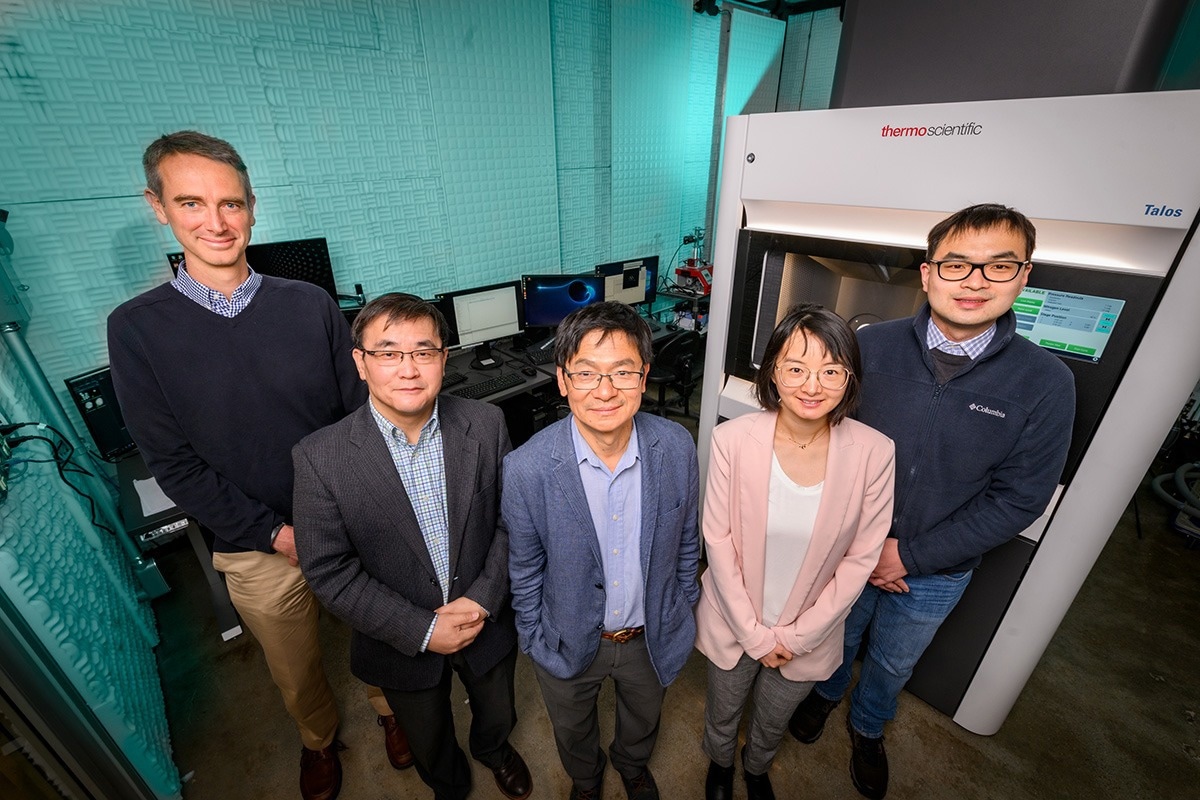A collaboration was made by engineers and chemists from the University of Illinois Urbana-Champaign to design improved rechargeable ion batteries. Researchers integrated a strong new electron microscopy method and data mining to optically stress regions of chemical and physical alteration within ion batteries.

From left, professors Paul Braun, Hong Yang, Jian-Min Zuo, Qian Chen and postdoctoral researcher Wenxiang Chen. Image Credit: Fred Zwicky.
A study headed by materials science and engineering professors Qian Chen and Jian-Min Zuo is the first to map out changed domains within rechargeable ion batteries at the nanoscale—a 10-times or more increase in resolution more than X-Ray and optical methods used at present.
The study outcomes are reported in the Nature Materials journal.
The team stated that earlier measures to comprehend the functioning and failure mechanisms of battery materials have mainly concentrated on the chemical effect of recharging cycles, namely the alterations happening in the chemical composition of the battery electrodes.
A new electron microscopy method, known as four-dimensional scanning transmission electron microscopy, enables the team to make use of a highly focused probe to gather images of the batteries’ inner workings.
During the operation of rechargeable ion batteries, ions diffuse in and out of the electrodes, causing mechanical strain and sometimes cracking failures. Using the new electron microscopy method, we can capture the strain-caused nanoscale domains inside battery materials for the first time.
Wenxiang Chen, Study First Author and Postdoctoral Researcher, University of Illinois
Qian Chen stated that such microstructural heterogeneity changes have been studied extensively in ceramics and metallurgy but have not been utilized in energy storage materials until this study was performed.
Zuo stated, “The 4D-STEM method is critical to map otherwise inaccessible variations of crystallinity and domain orientations inside the materials.”
The team made a comparison of its 4D-STEM observations to computational modeling headed by mechanical science and engineering professor Elif Ertekin to place such changes.
The combined data mining and 4D-STEM data show a pattern of nucleation, growth and coalescence process inside the batteries as the strained nanoscale domains develop. These patterns were further verified using X-ray diffraction data collected by materials science and engineering professor and study co-author Daniel Shoemaker.
Qian Chen, Professor, University of Illinois
Furthermore, Qian Chen schedules this study by making movies of this process—something for which her laboratory is popular.
The impact of this research can go beyond the multivalent ion battery system studied here. The concept, principles and the enabling characterization framework apply to electrodes in a variety of Li-ion and post-Li-ion batteries and other electrochemical systems including fuel cells, synaptic transistors and electrochromics.
Paul Braun, Study Co-Author, Professor and Director, Materials Science and Engineering, Materials Research Laboratory, University of Illinois
Scientists from Illinois named Andrew Gewirth, of chemistry; Hong Yang, of chemical and biomolecular engineering; and Shell researcher Ryan Stephens also took part in this study.
Journal reference:
Chen, W., et al. (2022) Formation and impact of nanoscopic oriented phase domains in electrochemical crystalline electrodes. Nature Materials. doi.org/10.1038/s41563-022-01381-4